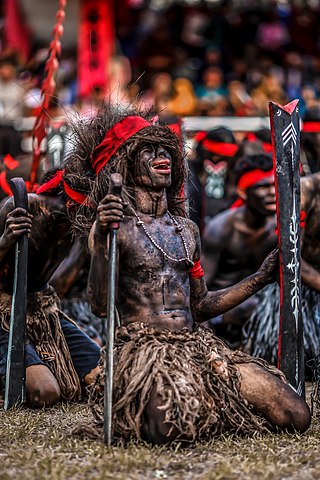Top Qs
Timeline
Chat
Perspective
Cakalele dance
Indonesian traditional war dance From Wikipedia, the free encyclopedia
Remove ads
Cakalele dance (pronounced "cha-ka-leh-leh", spelled tjakalele by the Dutch) is a war dance from North and Central Maluku in Indonesia.[1] Hybrid versions also exist among the natives of Sulawesi (Kabasaran dance or Sakalele of the Minahasan),[2] East Nusa Tenggara (Abui Cakalele from Alor),[3] the Tanimbar Islands,[citation needed] and Fakfak ( Mbaham-Matta's Cakalele Mbreh).[4] The dance is performed by men, two of whom represent opposing captains or leaders while the others are the warriors supporting them. After an opening ritual, the captains engage in a mock-duel with a spear (sanokat) and a long parang (lopu) while their supporters use a lopu in the right hand and a long shield in the left hand.[5] The shield is referred to as a salawaku, or by a local name such as the Tobelo o dadatoko.[6] The cakalele originated as a way for the warriors to celebrate after a successful raid. Dancers dress in full warrior costume and are backed by the rhythm of the drum (tifa), gong, and fife (suling).
Remove ads
Gallery
See also
Wikimedia Commons has media related to Cakalele.
Notes
External links
Wikiwand - on
Seamless Wikipedia browsing. On steroids.
Remove ads







